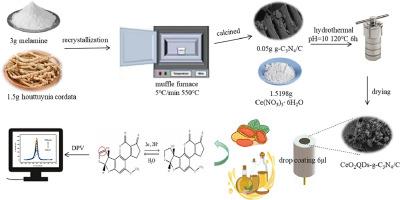CeO2QDs-g-C3N4/C 复合材料的制备及黄曲霉毒素 B1 的电化学测定
IF 8.3
2区 材料科学
Q1 MATERIALS SCIENCE, MULTIDISCIPLINARY
引用次数: 0
摘要
食品中黄曲霉毒素 B1 (AFB1) 的存在对人类健康构成了重大威胁,可导致癌症的发生。有效痕量检测技术的关键因素在于利用具有优异选择性和高灵敏度特性的传感器材料。本研究以三聚氰胺和蕺菜茎为起始材料,成功合成了具有高比表面积的 g-C3N4/C。通过水热法将氧化铈量子点(CeO2QDs)锚定在 g-C3N4/C 表面,制备了 CeO2QDs-g-C3N4/C 复合材料,CeO2QDs 的高氧化还原效率和小尺寸限制效应显著提高了传感性能。该复合材料通过 XRD、XPS、SEM、TEM 和 N2 吸附-解吸进行了表征。结果表明,CeO2QDs-g-C3N4/C 复合传感器材料具有比表面积大、微孔结构清晰、反应位点丰富等显著优势。此外,为了进行电化学研究,还使用 EIS、CV 和 DPV 进行了电化学活性测试。CeO2QDs-g-C3N4/C/GCE 对 AFB1 具有优异的电催化活性,线性响应范围宽达 100-1300 pg ml-1,检出限(LOD)低至 6.61 fg ml-1(S/N = 3),灵敏度为 0.985 pg μM ml-1μA-1。此外,稳定性、可重复性和干扰实验响应误差均保持在 5 % 以下。值得注意的是,该传感器材料在实际样品的 AFB1 检测中表现出了极佳的实用性,这也说明了它在食品安全评估中的巨大应用潜力。本文章由计算机程序翻译,如有差异,请以英文原文为准。

Preparation of CeO2QDs-g-C3N4/C composites and electrochemical determination of aflatoxin B1
The presence of Aflatoxin B1 (AFB1) in food represents a significant threat to human health, leading to the development of cancer. The key factor for effective trace detection technology lies in the utilization of sensor materials that exhibit excellent selectivity and high sensitivity properties. In this study, a successfully synthesis of g-C3N4/C with a high specific surface area uses melamine and houttuynia cordata stem as starting materials. A CeO2QDs-g-C3N4/C composite was prepared by hydrothermally anchoring cerium oxide quantum dots (CeO2QDs) onto the surface of g-C3N4/C, the high redox efficiency of CeO2QDs and the small size limitation effect significantly improve the sensing performance. The composite was characterized by XRD, XPS, SEM, TEM, and N2 adsorption-desorption. The results revealed that, the CeO2QDs-g-C3N4/C composite sensor material exhibited significant advantages with a large specific surface area, a well-defined micropore structure, and abundant reactive sites. In addition, electrochemical activity tests are conducted using EIS, CV, and DPV for the purpose of electrochemical investigations. The CeO2QDs-g-C3N4/C/GCE exhibits exceptional electrocatalytic activity against AFB1, with a wide linear response range of 100–1300 pg ml-1, an impressively low detection limit (LOD) of 6.61 fg ml-1 (S/N = 3), and a sensitivity of 0.985 pg μM ml-1μA-1. Furthermore, the stability, repeatability, and interference experimental response errors all remain below 5 %. It is also noteworthy that, the sensor material demonstrates excellent practicality in AFB1 assays conducted on real samples, which serves to illustrate its immense potential for applications in food safety evaluation.
求助全文
通过发布文献求助,成功后即可免费获取论文全文。
去求助
来源期刊

ACS Applied Materials & Interfaces
工程技术-材料科学:综合
CiteScore
16.00
自引率
6.30%
发文量
4978
审稿时长
1.8 months
期刊介绍:
ACS Applied Materials & Interfaces is a leading interdisciplinary journal that brings together chemists, engineers, physicists, and biologists to explore the development and utilization of newly-discovered materials and interfacial processes for specific applications. Our journal has experienced remarkable growth since its establishment in 2009, both in terms of the number of articles published and the impact of the research showcased. We are proud to foster a truly global community, with the majority of published articles originating from outside the United States, reflecting the rapid growth of applied research worldwide.
 求助内容:
求助内容: 应助结果提醒方式:
应助结果提醒方式:


